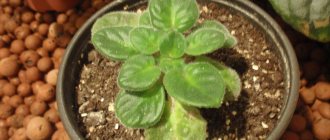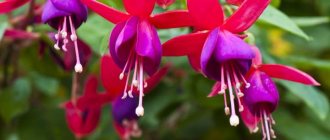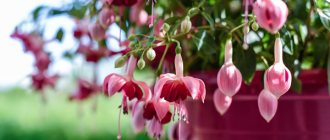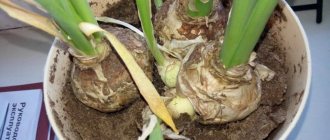Fuchsia does not bloom: reasons
Why fuchsia doesn’t bloom interests not only novice gardeners. This plant is very whimsical and can disappoint even an experienced gardener. There are many factors influencing the growth and flowering of a plant. Here are the main ones:
- illumination;
- air temperature;
- lack or excess of moisture;
- pests and diseases;
- soil composition.
If at least one of the parameters is not met, this leads to a decrease or complete absence of buds. Therefore, as quickly as possible, it is worth finding out why fuchsia does not bloom at home and what to do to correct the situation. There are reasons that can be eliminated immediately and allow buds to appear this year or prepare the bush for flowering next year.
Lack of light
Fuchsia is a light-loving plant; lack of lighting affects the appearance of buds. It is better to place the flower on the eastern, western and southwestern windows (sides of the site). It benefits from fresh air, so it is recommended to send the fuchsia pot to the garden in a pot for the summer, as it is, or replant it on the plot. But you will need to protect the flower from the wind, and on hot sunny days, shade it from direct sunlight.
Fuchsia does not bloom what to do
Important! When the buds appear, under no circumstances should you move or rotate the plant.
Air temperature
For fuchsia, air temperature is of great importance. In summer, on hot days (over 30°C), to prevent the buds from falling off, spray the flower itself and the air around it twice a day. For additional moisture in hot weather, place a small container with expanded clay and water. And the main condition for winter maintenance is the air temperature not higher than 15°C.
Lack of moisture
If there is a lack of moisture, the soil dries out, the foliage falls off, and budding may not occur at all. Good watering with settled water is recommended; there should be drainage at the bottom of the pot so that water does not linger, leading to rotting of the roots.
Pests and diseases
Fuchsia, like all plants, suffers from some diseases. She loves moisture, but its excess can cause gray rot. Brown spots appear on the stems and shoots are affected. The treatment is carried out with copper-containing preparations, such as foundationazole, pureflower.
Important! If root rot has affected the fuchsia root, it can no longer be saved; all that remains is to cut off the shoots and place them in a glass of water for rooting. In order not to provoke the disease, use a coarse-grained substrate, water it rarely but abundantly
Glyocladin is used for prevention
In order not to provoke the disease, use a coarse-grained substrate and water it rarely but abundantly. Glyocladin is used for prevention.
Their insects are loved by fuchsia spider mites, whiteflies, and aphids, so the plant must be inspected for the presence of these pests and treated with insecticides. For example, spider mites can be eliminated with karbofos.
Sometimes yellow spots appear on the underside of the leaf. This disease is called rust, which causes leaves and flowers to fall off. Treatment against it is carried out with the drugs Vertan, Bordeaux mixture, which are diluted strictly according to the instructions indicated on the package.
If the plant is affected by pests, but is still able to bloom normally, you still need to take all measures for treatment.
Reproduction methods
Seed (generative) propagation
To collect seeds from indoor fuchsia, its flowers will require artificial pollination. If you want to get a new hybrid, then during pollination you need to use different types of fuchsias, which differ from each other in the color and shape of the flowers.
Cuttings
When preparing cuttings, it should be noted that their length should be from 50 to 70 mm. In order for the cuttings to take root, they can be planted in sand or placed in a container with water. The cuttings will produce roots in about 20–30 days. To plant rooted cuttings, use separate pots up to 90 mm in diameter, which are filled with a soil mixture consisting of sand, humus, turf and leaf soil (1:1:1:1). In order for the bushes to grow spectacular and thick, several cuttings must be planted in 1 pot at once. Such bushes should have flowers this same year. To propagate slow-growing fuchsia species, the cutting method is used, and this procedure is carried out in the last weeks of summer.
FUCHSIA REPRODUCTION IS THE BEST WAY FOR FUCHSIA REPRODUCTION!!!
When and how often should nutrients be added?
Anthurium is a flower that requires regular replenishment of micronutrients. Fertilizers need to be applied both in the spring and summer, and in the fall. The frequency of procedures is every two weeks.
But not everyone knows how to fertilize anthurium at home in order to make it bloom as long as possible. In winter, the plant is fed no more than once a month, since it is in a dormant state.
For information! Particular attention should be paid to young plants; fertilizers are applied every two weeks for the first 6 months. Fertilizing is carried out regardless of the season. Fertilizer for anthurium should contain a whole range of useful microelements, given its luxurious large leaves and incredibly beautiful inflorescences
It is introduced only when the flower is completely healthy. If pests or signs of specific diseases were discovered, then first of all, you need to get rid of them, and then apply fertilizers
Fertilizer for anthurium should contain a whole range of useful microelements, given its luxurious large leaves and incredibly beautiful inflorescences. It is introduced only when the flower is completely healthy. If pests and signs of specific diseases were discovered, then first of all, you need to get rid of them, and then apply fertilizers.
How to make fuchsia bloom profusely
To create a beautiful shrub, a crown is formed by pinching. In February, it is transplanted by transferring from a small pot to a larger one just a couple of centimeters. Fuchsia will build up its root system and spend less energy on flowers.
Since the shoots of the plant have grown over the winter, the central stem and several branches are selected to form a crown and pinched at the required height. After a few weeks, the fuchsia will be covered in flowers.
Important! Excess shoots can be placed in water until roots appear, and then planted. The plant needs constant feeding, this is especially important during the flowering period.
How to feed fuchsia for abundant flowering? From spring to autumn, feeding (root and foliar) is carried out every week. The sheet is treated with plantofol in combination with zircon and epin. This will prevent the buds from falling off and will affect the abundance of flowering
The plant needs constant feeding, this is especially important during the flowering period. How to feed fuchsia for abundant flowering? From spring to autumn, feeding (root and foliar) is carried out every week.
The sheet is treated with plantofol in combination with zircon and epin. This will prevent the buds from falling off and will affect the abundance of flowering.
Applying fertilizer to the soil
How to make fuchsia bloom profusely
Flowering largely depends on the composition of the soil, what fertilizers are applied (dry or liquid) and fertilizers (mineral or organic). You can purchase ready-made soil at the store or prepare it yourself. The soil is suitable from a mixture of coconut fiber and any universal soil with the addition of vermicompost for softness and looseness.
Regardless of where you purchased the soil, it should definitely be calcined at high temperatures to destroy all microorganisms, disease spores, and weed seeds. Or this can be done by strong cooling: the soil is moistened with water, taken out to a frost not lower than −10°C and left for several days. Freezing destroys all pests, but, unfortunately, beneficial bacteria too. Such procedures are carried out 2-3 times, then the soil is watered with biological products, for example, phytosporin, which contains microorganisms. In this state, the soil is left in a bag for 2 weeks.
Fertilizers for fuchsia are selected depending on the growth phase:
- young specimens need fertilizing with a high nitrogen content to increase green mass and the growth of young shoots;
- to make fuchsia cover itself with abundant flowers, you need to add fertilizers that include phosphorus and potassium;
- when treating the bud with the drug, the color turns out bright and saturated;
- It is good to alternate watering flowers with mineral and organic compounds.
Important! Under no circumstances should you water plants with fertilizer in dry soil. For 2 - 3 hours, the soil is spilled with clean, settled, warm water, and only then solutions with useful microelements are poured
Knowing how and what to feed fuchsia, you can speed up plant growth, help it bloom on time, and increase resistance to various diseases.
Time and quantity of watering
During the period when the plant is actively growing and blooming, watering should be plentiful and frequent. There is an opinion that 90 out of 100% of the life activity of fuchsias depends on irrigation. Although they are considered to be moisture-loving, the majority of flowers die from overwatering, and it is impossible to save a flooded plant. For example, in indoor conditions, if fuchsia has dropped its leaves and buds, you need to check the soil for moisture. If it is very damp, it is worth taking the flower out of the flowerpot, with the remaining roots (white in color) transplanted into another soil, covered with a bag and left in the shade.
Overdrying the soil is also dangerous, as leaves and buds may fall off. The flowerpot is completely lowered into the water until it fills with water, and the plant itself is sprayed with a spray bottle. In general, it is better to spray fuchsia more often and generously than to flood it.
Both experienced gardeners and novice amateurs can cope with fuchsia only if they do everything as described above
It is very important to know how fuchsia grows and what to fertilize it with, then the result will not be long in coming. The plant will thank you with abundant bright flowering
Possible problems
The reasons why this situation arises may be different. Let's look at the most common and simple ones:
Lack of light. Due to the low level of illumination, the shoots turn pale, elongate and the plant, of course, does not have time to flower, because it puts all its energy into growth and development. In order to correct the situation, you need to provide the flower with enough light. Extremely stuffy indoor conditions. The temperature issue is very important for a flower; if you provide it with too hot an environment, then it will not bloom, because all the nutrients and moisture will be used to compensate for environmental conditions. To fix the problem, you will need to normalize the temperature. Once this is done, after some time the flower will return to normal and will be able to bloom. No or low amount of fertilizers
If there is a lack of fertilizer, the plant will also not bloom, just like if there is an excess of it, so it is important to ensure that the amount of fertilizer is always within the normal range. Then the plant will successfully develop and bloom every year
Important! Fertilizers that contain potassium and phosphorus are most preferable for plants. Since it is precisely these substances that fuchsias lack most for full development. Poor watering. If the plant receives insufficient or excess moisture, this may cause a lack of flowering. Watering is a very important process; if it is done incorrectly, the negative consequences can even lead to the death of the plant. To prevent this from happening, you need to normalize the frequency of watering. Disease or harmful insects. This is another reason why the plant may not bloom. If these pests are not eliminated in time, they will take nutrients from the plant, and in some cases, eat the plant.
These are the mistakes gardeners, especially beginners, make most often. If you take the necessary measures, then everything will quickly fall into place and the flower will soon bloom. But sometimes the reason for the lack of flowering can be something longer and more complex; sometimes such a problem cannot be solved too quickly.
More complex reasons may include the following:
Providing unsuitable temperature conditions for the winter period. If you create a temperature of up to +15 degrees in winter, the plant will actively grow and develop, because of this, in the spring it will be too weak to produce flowers. In order to avoid this situation, you need to provide the plant with the correct temperature regime. Incorrect pinching or trimming. If these procedures are performed incorrectly or at the wrong time, this can lead to a lack of flowering.
Important! The plant should be pinched when it has several pairs of leaves. Pot too big to grow. This will lead to the fact that the plant will be maximally focused on growing the root system for a very long time
Such actions will be associated with the need to fill all the empty space. As a result, fuchsia will not bloom. Excess of nitrogen fertilizers. Like an excess of any other fertilizers, an excess of fertilizers of this type will not lead to anything good, because they help the plant to grow and develop foliage, but not to bloom. Low quality substrates. Poor quality soil will lead to aridity; this phenomenon will negatively affect the root part of the plant. The plant will not have enough nutrients and will not have the strength to flower. Having problems with roots. Excessively hot or cold conditions, as well as problems with watering, can lead to problems with the root system, after which the plant will stop blooming, directing all its energy and resources to maintaining its roots in good condition. Features of the selected plant variety. Some types of fuchsia may simply bloom late. In this case, you should not take any specific measures, you just need to wait some more time and the plant will definitely bloom. Such information should be clarified initially, before the flower was purchased.
Transplanting a plant
Fuchsia is considered a fast-growing plant, which is why it must be regularly replanted in a container of suitable size, which should be 3 cm larger than the previous one. It is best to transplant in the spring - during the awakening and growth of the plant.
It is recommended to use a ceramic pot, as it can protect the root system from overheating in the summer. Do not forget about the drainage layer, the thickness of which should be 2-3 cm. The drainage layer protects the root system of the plant from rotting. It is recommended to use a purchased soil mixture specifically for flowering indoor plants as a substrate.
You can also prepare the soil yourself. To do this, the following types of soil are mixed in equal parts:
- turf land;
- leaf soil;
- peat;
- humus;
- coarse river sand.
Transplantation is carried out using the transfer method: a little prepared soil is poured into the container onto the drainage layer, after which the plant is carefully removed from the old pot and, together with the earthen lump, is placed in a new container. All voids on the side must be filled with soil mixture.
After transplantation, the flower is placed on a shelf with diffused light. It is also necessary to cut the flower stems to 1/3 of the length. The leaves are sprayed, and the substrate is watered with settled water and wait until all the excess water drains into the pan; the excess moisture must be drained.
After the transplantation procedure, the plant is not fed for a month. Now you need to wait a couple of months for the fuchsia to please you with abundant flowering.
If you are planning to propagate a flower, then it is best to do this by cuttings. Fuchsia can also be propagated from seed, but this method is rarely used, since a lot of time passes from the moment of sowing until a flowering plant is obtained.
Pruning and shaping fuchsia after flowering
Fuchsias respond well to heavy pruning.
Flowers grow only on young shoots. To form flowering next year, at the end of winter - beginning of spring, fuchsia is heavily pruned. About two-thirds of the above-ground part of the plant is removed, incl. dead and diseased parts of it. This pruning rejuvenates the fuchsia and leads to abundant flowering in summer and autumn.
- Before pruning (12 hours before), water the plant.
- Remove dead, damaged, thin and crossing branches.
- Cut out weak, broken and damaged branches back to the main stem.
- Pruning vertical stems, from 1/3 to half of summer growth.
- Trimming healthy stems. The result of pruning is that each branch should have no more than three new buds. The side branches form the shape of the above-ground part of the plant; pruning them is intended only for this purpose.
- Remove old leaves (to prevent pests).
Tips and warnings
Each time the stem has grown to two internodes, pinch it above the second internode to improve branching. Repeat this procedure two to three times during the spring and summer. As soon as flowering on the stems stops, the stem is cut back to the next internode.
Trimming multiple fuchsias with one pair of scissors can transfer pests from the infested plant to others.
Diseases and pests. Fuchsia is damaged by aphids, whiteflies, spider mites, powdery mildew, gray mold and rust. For a detailed description, see the corresponding chapters: “Diseases” and “Pests”.
Main problems when growing
Fuchsia leaves are falling off. Probable causes: warm dry air, insufficient watering or lack of light.
Fuchsia's buds are falling off. Probable causes: violation of the watering regime (too much or too little water), insufficient lighting, too warm air, or perhaps the pot was moved to another place, or turned in relation to the light.
Short flowering period. Possible reasons: the plant is kept in a warm room in winter and watered abundantly, or it is fed little and not watered enough, or it does not have enough light during the growth period.
Brown spots with yellow edges on the leaves. Probable cause: waterlogging of the soil during the cold season.
Why does it drop buds and leaves?
Fuchsia sheds its leaves and buds for several reasons. This mainly happens due to improper care.
Incorrect lighting
Lack of lighting causes the shoots to turn pale and elongate. Fuchsia becomes weak and loses its ability to bloom. The leaf blades grow small, wither, and the buds do not open.
But at the same time, sometimes gardeners go to the other extreme and place the plant in the sunniest place. In this case, the leaf plates get burned and the buds dry out.
Incorrect feeding
Fuchsia blooms only after the growth of green mass
If the fuchsia pot is too small, then additional nutrition will not save the plant. First you need to change the flowerpot to a larger one, and then just add fertilizer. In addition, the small volume of the pot leads to an increase in the amount of salts in the soil, which also leads to a stop in the development of the crop.
Poor watering regime
The flower is characterized by a rapid reaction to overdrying of the substrate. Therefore, if there is a lack of moisture, it immediately drops the buds (both open and closed). In addition to dropping the buds, the green mass begins to wilt.
But you shouldn’t fill the substrate either, as this is fraught with rotting of the rhizomes.
Topping
Pinching is necessary for the development of new shoots and the formation of flower buds. This procedure is carried out regularly - once every 3-4 months. But at the same time, excessive and frequent removal of damaged shoots can lead to a lack of flowering.
The plant can even shed already formed buds. In addition, improper pinching causes prolonged formation of buds. As a result, they do not have time to open up and fall off at the end of the season.
Diseases
Fuchsia does not get sick very often. But if you do not start timely and correct treatment, the entire plant may die. Usually the buds do not fall off immediately, first the petals begin to dry out (or change color at the edges to yellow and black), then the disease spreads to the green part of the plant, and after that it completely withers.
How to care during flowering
A flowering plant requires special care. Basic Rules:
The flower pot must be placed on the sunny side. However, during hot summers, it is necessary to ensure that the plant receives shade to reduce the risk of yellow spots on the leaves. It is necessary to promptly remove all dead leaves and young shoots growing from the root. The plant needs to be watered every 4-5 days
It is important to ensure that the water does not accumulate and spreads well throughout the pot. You need to water the soil only after it is completely dry. Once a week, you need to loosen the soil in a pot of geraniums.
This will reduce the risk of rot on the roots and saturate the soil with oxygen.
Caring for geraniums during flowering
During the flowering period, a large amount of nutrients in the soil can harm the inflorescences and shoots. However, with prolonged flowering, it is necessary to use potassium fertilizers. You can feed the flower with water with iodine. To do this, you need to dilute a drop of iodine in a liter of liquid. This watering will make the flowering lush and the color of the buds bright.
Important! During the flowering period, replanting the bush and cutting young shoots is not carried out. It is also not recommended to trim bushes
Fuchsia - home care
When it comes to caring for fuchsia in your home, you need to focus on the conditions in the apartment. Compact shapes, resistant to bright light, suitable for window sills. Shade-tolerant species can be placed in pots inside the room. Ampel varieties feel good on suspended structures, standard ones - on a table or a special stand. If you do not know the acquired variety, then create average conditions for your fuchsia, adjusting its formation as it develops and taking into account the growth force.
Homemade fuchsia flower - watering
In the absence of fertilizers, the plant can develop, but without water, any organism will quickly wither
When studying the problem of how to care for fuchsia at home, you need to pay special attention to watering. Excess moisture leads to rotting and disease, but it is advisable to ensure that the soil in the pot is completely saturated with liquid
Watering is carried out when the top layer of soil dries. Blooming fuchsias require this procedure more often when cared for in summer. In hot weather, water the plant every 3 days or more often.
Fuchsia - feeding at home
Fertilizer application is beneficial during the growth period - from April until the arrival of cold weather. When caring for a fuchsia flower, it requires one feeding with complex preparations for 2 weeks. In winter, the plant is in a dormant stage and does not need stimulation. If you have transplanted, you should not rush; resume feeding a month after the fuchsia has adapted to the new conditions. Both root and foliar methods of applying fertilizers are suitable.
Fertilizers are not applied to dry soil; before this procedure, the soil should be watered a little. To stimulate the formation of buds, the crown is treated with Zircon, then the fuchsia needs phosphorus-potassium fertilizers. Balanced fertilizers of old and new brands for flowers are suitable - “Spring Effect”, “Planta Miracle-Growth”, Pokon, and other proven preparations.
Plant care in winter
The most difficult thing in caring for fuchsia is organizing a cool winter for this plant. The further growth and flowering of the plant depends on this. The main task of keeping fuchsia in winter is to slow down its growth. Therefore, the air temperature is reduced as much as possible, but it should not fall below 5ºС
Also important is timely soil moisture and good lighting.
Fuchsia overwinters best on an insulated and glazed balcony or loggia. Here in winter the temperature suitable for its wintering is set.
Also, under these conditions, the plant can be provided with good lighting, which is also important for maintaining powerful shoots
How to water fuchsia in winter?
During the dormant period, fuchsia is rarely watered.
At low temperatures, the soil in the pot dries out very slowly, so water it no more than 2 times a month.
Overmoistening in such conditions is detrimental to the flower, since there is a high risk of developing pathogenic fungal infections. During cold wintering, the flower does not need spraying.
If it is not possible to move the flower to a cold room, you can organize wintering on the windowsill.
To grow fuchsia, choose the coldest window sill, far from the radiators and facing southeast. It can be quite cold in such a place in winter. To reduce the temperature, you can open the window for light ventilation.
It is impossible to set the temperature on the windowsill in the apartment low enough, so the flower will grow. But its increase will be much less than at room temperature. Good lighting will prevent the shoots from stretching, which will ensure abundant flowering in the summer.
Now you know the features of caring for fuchsia in winter at home.
How is growing in open ground different from keeping a house in a pot?
Fuchsia is known as a house plant, but outdoors it can present itself in a different way. Garden fuchsia includes the best qualities. Having transplanted the plant into open ground, you will no longer recognize it, it will surprise you with its flowering, and its rapid growth and powerful growth will turn your flower into a small tree.
Fuchsia blooms in the open ground all summer, and in the fall care consists of digging up the plant and sending it to spend the winter in a cool and bright room. Just as with indoor growing, outdoor fuchsia bottoms are suitable for windless areas, preferably under the wall of a building, with sufficient lighting. Unlike home fuchsia, neutral soil may be suitable. Despite being grown outdoors, fuchsia still needs periodic watering.
A plant in open ground always grows faster and has more lush flowers than representatives living in apartments. Outdoor care involves preparing the plant for winter, which involves digging up the flower and gradually reducing its watering. During wintering, homemade fuchsia will only need a cooler place.
Reference! If you live in a private house, your choice should fall on growing fuchsia in open ground. The plant is more suitable for growing in the garden than others, and we described above how to preserve it until spring.
Diseases and their prevention
Diseases usually affect fuchsia, like all indoor plants. If you pay enough attention to the flower, then you don’t have to worry about diseases and pests. If a problem is detected, you just need to eliminate the source and the plant will recover on its own. Diseases can be divided into two categories :
- Diseases from improper care.
- Damage by fungus and various pests.
If watered incorrectly, the roots may begin to rot . How to preserve the plant in this case? To restore the health of the flower, it is necessary to reduce watering. If a fungus or other damage to leaves by parasites is detected, it is necessary to purchase a special product in the store and isolate the fuchsia from other plants for the duration of treatment.
Fuchsia can be proud of its noble origins. The first plants were imported to Europe at the beginning of the 19th century, and since that time, breeders have developed many varieties. Fuchsia is an evergreen shrub that will grow wonderfully both in an apartment and in a garden plot.
How to fertilize correctly?
A prerequisite for bright fuchsia flowering is fertilizing with fertilizers. Fertilizers should be purchased in special stores, since ready-made fertilizers maintain the ideal balance of organic minerals and elements specifically for this type of plant.
Do not overdo it with fertilizing; if there is excess fertilization, fuchsia begins to grow actively and practically does not produce flowers. It is best to feed the flower no more than twice a month.
It is not recommended to use fertilizers of unknown origin, and fertilizers that are intended for other types of plants. In winter, fuchsia is dormant and does not need fertilizer.
Pinching and trimming
Indoor fuchsia flowers form on young shoots. In order to have more of these shoots, it is recommended to trim the plant regularly, as well as pinch out young shoots.
Pinching is an effective method to make fuchsia bloom more abundantly. Using pinches, you can form the desired shape of the plant: give it the appearance of a ball, a bush or a small tree in the form of a bonsai.
Depending on the variety, fuchsia can grow up to 3 m in height and even higher. When kept indoors, such a plant will be quite difficult and impractical to grow. Low-growing varieties or ampelous fuchsia are preferred for the room. The plant is pruned twice a year: in autumn, at the end of flowering, in October, and also in winter, in early January.
When you prune for the first time in the fall, you need to remove all faded branches at a height of 2 cm from the dormant buds. It is necessary to carefully inspect each branch for the presence of pests, remove all excess seed pods and outdated flower stalks. If you find pests, you need to cut off severely damaged parts of the plant and treat the entire flower with an insecticide.
The second pruning is carried out in early January to finally form the crown of the tree. If the fuchsia was in the garage or basement in winter, then the plant is pruned only in the fall. In spring, only the resulting dry leaves and shoots need to be removed.
If the fuchsia spent the whole winter in the room, then in winter it must be trimmed. Using garden shears or clean pruning shears, remove all thin and long shoots. As a rule, such shoots will not bloom luxuriantly and will spoil the decorative appearance of the entire bush.
With periodic pruning, the plant will grow in width instead of height. It is best to prune old, woody shoots as well, since they consume nutrients and almost never produce flowers. All flowers bloom only on young branches. Soon a beautiful and strong bush begins to form.
If you want to form a bonsai tree from a fuchsia tree, then you need to leave one shoot or, conversely, several such branches that can be easily twisted together into a common trunk. At the same time, the tops are pinched to form a lush crown of the tree.
Pinching should be done in winter, when the plant is dormant. All unnecessary shoots are removed, leaving only a few branches on the central trunk. We'll have to see what comes of it in the spring. If the crown of the plant is not yet fully formed the way you would like, the flower must be pruned again in the spring.
Different, bright and multi-colored indoor fuchsias are considered a precious exhibit in the collection of every gardener. If you still haven’t purchased this indoor flower or doubt that you won’t be able to care for the flower, then it’s in vain. Even a beginner can grow and care for fuchsia at home if the basic rules are followed.
Types of home fuchsia with photos and names
Fuchsia graceful
Fuchsia graceful is a small shrub up to 1 meter in size. The flowers are drooping, bell-shaped, with a pronounced reddish tint. The calyx of the flower is formed by four concave petals, of a reddish hue. The corolla is much shorter in length than the calyx. The color is usually a bright purple hue.
Fuchsia Magellanica
The shrub reaches a height of five meters. However, as a rule, there are specimens up to 2-3 meters. The Magellan species is native to South America, particularly Argentina and Chile. The leaves are elongated, reaching a length of up to 5 cm. The veins are purple, the tips of the leaves are jagged. The flowers grow solitary, often collected in groups of 4-5, drooping. Oblong in shape, reminiscent of a funnel, with a slight reddish tint. Petals at the base with a slight blue tint.
Fuchsia brilliant
Evergreen shrub, up to 1-2 meters high. Habitat: Mexico. The leaves are large, oblong in shape. They reach a length of up to 20 cm, a width of 10-15 cm. The corolla is an elongated narrow tube up to 10 cm long. Inflorescences are racemose. Blooms profusely from June to August.
Fuchsia boliviana
Branched shrub, evergreen. Homeland - South America. Often found in Ecuador, Guatemala, Bolivia. Maximum height 1-1.2 meters. The ovoid leaves reach 15 cm in length. The flowers are tube-shaped, large, bright red.
Fuchsia - growing features
For fuchsia, cultivation is suitable at a temperature of 18-22 °C in the warm season; in winter we reduce the temperature by 3-4 degrees. Climate fluctuations cause buds to fall off. When it gets cold or very hot, the leaves become smaller, change color, and the risk of fungal infections increases. By the end of autumn, fuchsia is preparing to rest, the formation of new buds stops, the growth of shoots and leaves slows down.
Soil for fuchsia at home
An elegant and decorative home flower, fuchsia is an undemanding plant; it grows in any fertile soil with a neutral reaction. You can improve the quality of the soil by adding useful components to it. To grow and care for adult fuchsia at home, take a mixture of peat, humus, turf soil, compost, leaf soil, and clean river sand.
Pinching fuchsia at home
Without normal care and formation of the cuttings, the flowerpot develops randomly, becomes elongated, and produces few flower stalks. Some varieties practically do not branch on their own in nature; they have to be stimulated artificially. There are no difficulties in the question of how to pinch fuchsia at home. By performing this necessary operation, the grower removes the growing point, doubling the number of shoots. In winter, in this way we help the flowerpot not to stretch out. At home, ampelous forms of adult fuchsia are pinched over 2-3 pairs of leaves, bush forms - over 3-4 internodes.
How to form fuchsia at home?
It is advisable to replant the old plant annually and form the crown. In March, flower growers are engaged in removing shoots and feeding bushes. After stimulating procedures, fuchsia wakes up, cultivation and care according to all the rules of agricultural technology starts the buds to grow even on old woody parts of the shoot. Bush forms are given time to grow, shortening the crown when the required height is reached. The formation of adult fuchsias is completed by the beginning of April.
Rules for the formation of fuchsia:
- The first time we pinch a fully rooted cutting above the 3rd pair of leaves.
- We shorten the side shoots at the same time to give the fuchsia the required shape.
- A compact plant is obtained by pinching over the 2nd pair of leaves; full formation takes up to 3 months.
- For flowering, pinching should be stopped after obtaining a strong bush. It must be remembered that buds take from 6 to 12 weeks to form.
How to replant fuchsia at home?
The time to transfer the plant to a new pot comes when the entire earthen ball in the container is filled with the root system. If small roots begin to appear from the drainage hole, then you should start working. Fuchsia is transplanted at home into a pot 2-3 cm larger. Do not compact the soil too much with your hands; light tapping is enough. After a while it will sit down on its own; you can add a little soil if necessary.
When to feed and water indoor plants
Although plants require minerals for good growth, when feeding, you need to take into account that different types of fertilizers can be used depending on the time.
Applying liquid fertilizers is an important step in caring for any flower.
For your information! Flowers may only need fertilizing during the active growing season. The rest of the time it is harmful to do this. However, you need to understand that the characteristics of the growing season may differ for different species. For example, at home, some flowers may not have a dormant period at all. Thus, their growing season occurs throughout the year.
Spring and summer are the times when you need to feed all the flowers growing at home. Increasing the duration of daylight hours promotes active growth and flowering.
The beginning of the growing season falls at the end of February or March. The exact time depends on the climatic and weather conditions of the region. For most plants, this period ends in autumn. Reducing daylight hours indicates to houseplants that a dormant period is about to begin. This usually happens in October. Therefore, for most types of feeding, feeding ends in September.
During late autumn and winter, you need to monitor whether the time of rest has come for a particular flower. If this is the case, then no fertilizing is applied at the specified time.
However, a situation may arise where flowering continues into late autumn and winter. In this case, you can be sure that the dormant time has not come for this flower, which means you need to continue to feed. It is worth considering that in this case their intensity must be reduced. In winter, plants lose the ability to absorb the same amount of fertilizer as in summer. If this is not observed, then house flowers may get burned from excessive amounts of fertilizing.
Fuchsia diseases
To begin to properly fix the problem, you need to determine the cause. Common options according to leading botanists:
- the appearance of pests;
- bad light;
- lack of nutrients.
What to do if fuchsia leaves curl
The problem of reducing daylight hours is easily solved by organizing illumination with lamps in winter, and in summer the flower should be moved to the most illuminated place, but avoid direct rays of the sun. This causes the leaves to turn yellow.
In good light, leaf curling and yellowing indicates a lack of macro and microelements. Potassium, zinc, molybdenum are the main flower nutrition in case of this problem. The sheet plate will tell you which element is missing.
Note! The leaves curl upward due to a lack of zinc; inside - molybdenum. The shape of the leaflets changes with a lack of minerals in general
Pests and parasites can cause leaves to curl in a young plant. In a flower garden, caterpillars undermine the roots and stems, the leaves wither and curl. Removing the caterpillars and treating with insecticides will save the flower.
Aphids and nematodes can settle on the leaves. They are hardly noticeable because they bite into the leaf. Having lost their juices, the leaves curl. Control measures are the same as for whitefly. Preventative measures with insecticides will kill the clutch of insects in the early stages of reproduction.
Varieties of fuchsia by structure
Plant growers classify a flower by the type of shoots and buds. There are bush and hanging varieties of fuchsia. Both types are similar in spectacular beauty, but have a number of differences.
Ampelous
These varieties actively grow lateral shoots. Hanging pots are chosen for flowers and placed on balconies and facades. In winter they are brought indoors. Ampelous fuchsias are undemanding in care.
Varieties suitable for beginners:
- Anabelle. Peduncles are abundant white.
- Imperial Crown. Long shoots with red flowers.
- Blue Angel. The branches are long and the flowers come in white and red.
- Ballerina. Peduncles are large, two-colored.
They also choose Hollies Beauty, an extremely easy-to-care variety with large white-red buds. The only condition for abundant flowering is diffused light. In direct sunlight, the plant withers and the flower stalks die.
Bush-like
Bush fuchsia is grown in open ground. From one shoot, trees with a lush crown are obtained. The crown is formed from the main trunk, the side shoots are completely removed. Some plant growers leave several side branches to increase the fullness of the crown.
Varieties suitable for beginners:
- Gotha. The flowers are burgundy, the stamens are large and dense.
- Alisson Bel. The spectrum of colors is purple with red hues. The petals are silky and elastic.
- Henriette Ernst. The flowers are very large and red; in extreme light they show a silvery tint.
Advice! For plants, choose illuminated areas on the eastern side of the flowerbed. This way the flower will receive enough sun, but without direct burning rays. During the summer heat, bush fuchsias are shaded.











